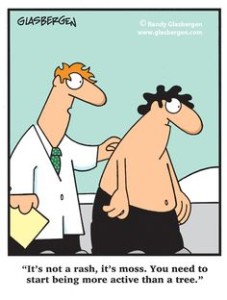Yet another report has come out about disease risks with a sedentary lifestyle (http://bit.ly/1MF3r4m). The researchers in this study discovered that there was a 20% increase in chronic kidney disease for every 80 minutes/day of sedentary behavior, aka sitting on the buttocks. Small wonder.
While there is still much to be examined and tested, as they noted, the conclusions do not reach any level of surprise. Granted that not everyone who sits around will suffer from kidney disease, but those who do not or cannot inject a more active lifestyle into their day (in consideration of any hereditary factors) will likely be susceptible to some type of disease or ailment at some point.
Ask anyone in their late 30’s and above, who don’t take time to stretch during the day, how many mornings they wake up with a twinge in their back or even when making a bending movement where a strain is put on an underdeveloped back muscle? How much could high cholesterol, diabetes or any cardiovascular disease (again, in consideration of any hereditary factors) be prevented by an adjustment of diet and an increase in exercise?
We are all guilty at times of unconsciously adjusting our lifestyle behavior in the wrong direction (larger meals, more snacking, increased time with the TV or computer, parking closer and closer to a store as we increase in years). While there may be examples of people living into their 90’s or 100’s with little movement in Japan and China, many factors of their diet, hereditary genes, attitudes (yes, a positive nature can help), or any type of exercise they participate in such as Tai Chi are not always mentioned.
Further studies on effects from sedentary behavior will always be conducted because they are easy to perform. Ten countries in the world, including China have already been identified with a great percentage of an overweight population. Unsurprisingly, the U.S. is at the top of the list.
Perhaps, a positive change in the percentages will occur with more informative health education at the local level or free community programs that will demonstrate the health benefits and encourage self-responsibility. Certainly the movement by many grocery stores to put fruit and vegetable stands nearer the front entrance can help remind us to change the balance in our daily meals. But the desire to be more active remains a lifestyle choice and responsibility of the individual.

